Hitting a Nerve – TMD (Revisited)

Chapman Clinic for Spinal Epigenetics
Dental based treatment for TMJ Dysfunction and malocclusion may be enhanced by combining therapy with Atlas Aligning Chiropractic procedures known as Atlas Orthogonal. Essentially, getting one’s head on straight through specialized atlas postitioning technology can make all the difference in whether the TMJ treatment is successful or a failure.
The Atlas Orthogonal (AO) procedure can restore the essential balance and positioning of the head, neck and back–a vital part of jaw function.
Malpositions of the head and neck are often associated with a common jaw disorder called Temporomandibular Joint (TMJ) Dysfunction, or TMD. TMD is also known as TMJ Syndrome. Patients that present to a specialized dentist for TMJ treatment are often not diagnosed for craniospinal dysfunction, hence, with only half the correct diagnosis, only a partial therapeutic program is recommended.
UNDERSTANDING THE TEMPOROMANDIBULAR JOINT (TMJ):
The jaw joint is way more than a “functional hinge” joint—it is more accurately described as being suspended and “docked” in the TMJ space rather than being anchored there—much the way the boat occupies the space in a slip. In the illustration below, you can see that when the mouth is open, the head of the condyle moves down and forward. The jaw or mandible is positioned and moved by 68 pairs of muscles of the head, neck, face and shoulders, and, unlike the vast majority of other joints of the body—which remain in their location during joint range of motion—the jaw joints are compensating joints to some extent, and glide into and out of the TMJ space based on its’ natural functional movement. Therapeutically, I have found that it helps to view the tempromadibular joints as more of a biomechanical “reference point”, rather than a fixed pivot or anchor point. TMJ function, it’s neurology and ability to compensate can be a complex clinical condition.
I cannot underscore the importance of having a multidisciplinary understanding of the mandibles sophisticated behavior patterns and it’s relationships with other structures such as the atlas and the axis vertebraes (C1 and C2), as well as the 68 pairs of muscles that move and position the jaw—-this knowledge is essential when treating complex TMD.
The good news is: Although the TMJ is very complex, it does have a simple, identifiable “axis of movement” — and that axis of motion is not in the jaw joint itself! Rather, the axis of angular rotation of the mandible is around a very important structure in cervical spine, namely, C2 vertebrae, also known as the Axis (red line). The upward jutting structure on the Axis vertebrae around which the jaw “functionally” pivots on it’s several axes is called: the “dens”. The name “dens” provides an important clue, for in Latin, dens means: “tooth”!! So, the functional axis of the jaw, and hence the dynamic pivot of occlusion, takes place around the only part of the human spine which anatomists—centuries ago I might add—dubbed the “Tooth of the Spine”… Amazing, isn’t it!?
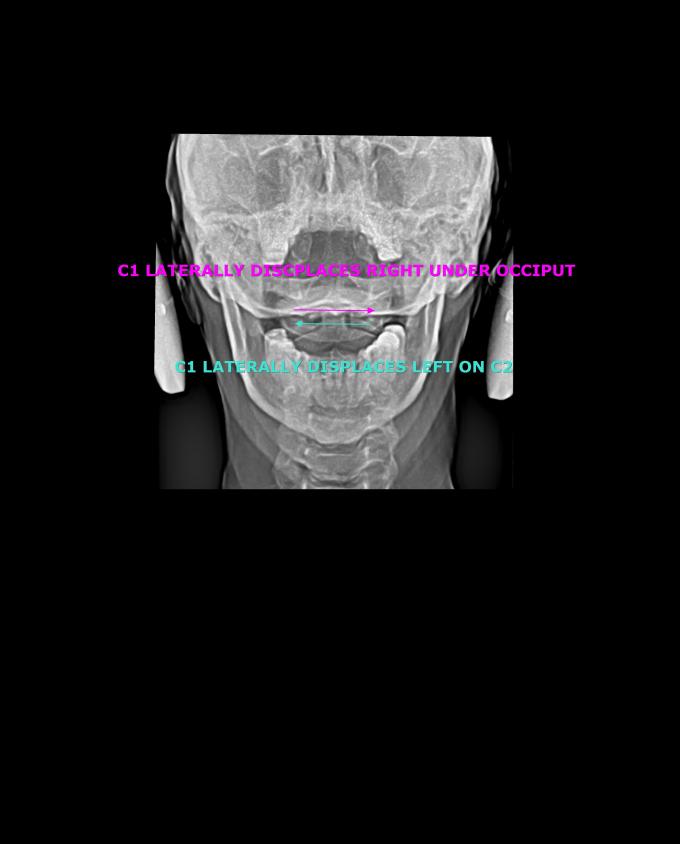
TMD Syndrome may occur when the normal functional “positions” of the jaw joints shift into irregular positions during movement and use. An uneven “grinding” or “wearing” use-pattern will likely develop, and is measurable through specialized instrumentation. This abnormal use-pattern and positioning can cause a significant amount of pain and inflammation–it can even cause tooth wear patterns, and may make chewing, sleeping, speaking and even breathing difficult.
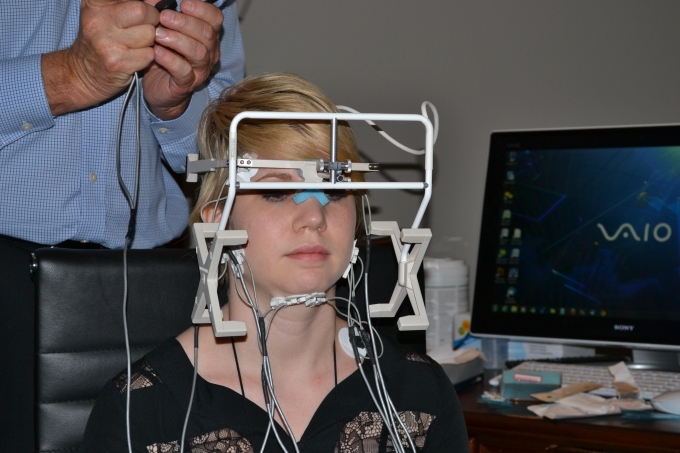
The pain and problems of TMD can be quite diverse. Jaw disorders can refer pain to other parts of the body–even though the jaw may not noticeably be painful itself. It can refer pain to the head, neck and upper back, the face and the teeth—–and even the entire body, including the hips, knees and feet! This multisystem effect can cause the patient to seek out multiple practitioners for treatment for their “whole body” symptoms. Unfortunately, those various practitioners often find it difficult to blend their procedures with the processes and procedures of other practitioners for the good of the patient. This happens not because they are bad doctors, but because our system of healthcare does not facilitate multidisciplinary collaboration—especially between certain types of practitioners. The reasons for this sort of discord are complex in and of them selves, but I do believe—and with good reason—that this is where many TMD therapies fail.
It is sort of like herding cats…

From my clinical experience, TMD disorders, even advanced and complex cases of TMD, where vast postural compensation has occurred in the jaw muscles, occlusion, the spine and pelvis, respond well with Transdermal Atlas Positioning (TAP) treatment via the Sweat AO instrument in conjunction with advanced dental technologies such as biomimetic occlusal therapy such as a specially designed and fabricated intraoral appliance which we call the Epibite. To help the reader better understand the nature of the TAP procedure, I have taken a few paragraphs to carefully and accurately describe the Transdermal Atlas Positioning procedure itself.
The TAP Procedures in performed on an Atlas Orthogonal (AO) instrument and is a corrective cervical spine alignment procedure performed by Board Certified Atlas Orthogonists (BCAO) chiropractic physicians. (These are upper cervical specialists who have attained a certified proficiency in the use of the Sweat Analysis and the AO instrument)
The AO or TAP specialist utilizes 3-dimensional images (via CT or X-ray) to locate and identify abnormal malpositions of the skull, the atlas, the axis and the other 5 cervical vertebraes. Once the exact malposition has been mapped out in 3-D space, a biomechanical analysis protocol is used to derive a mathematically formulated vector.
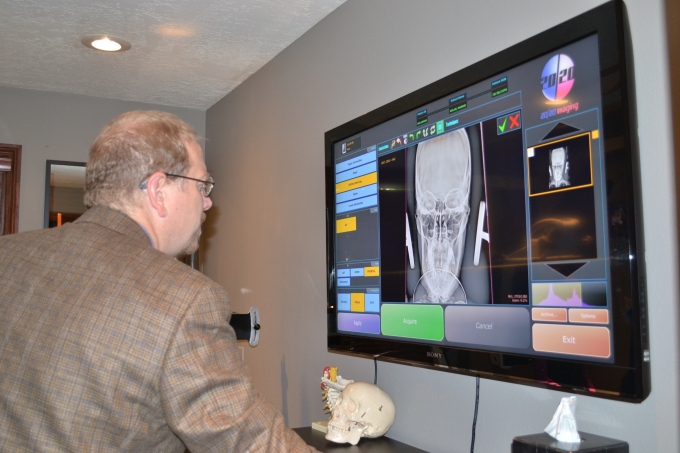
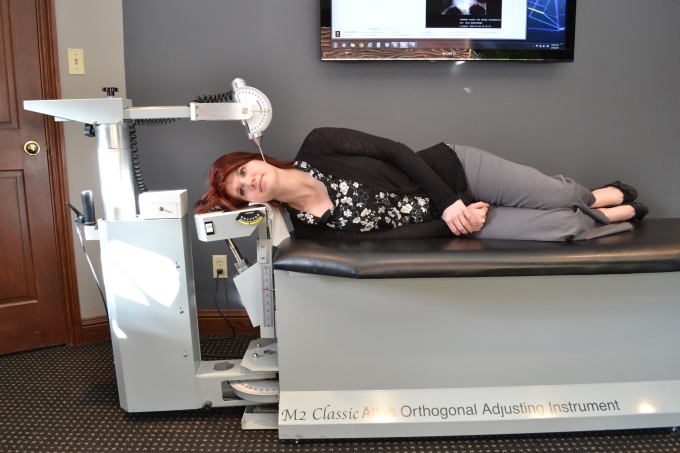
The above process may need to be repeated, refined to achieve complete and stable alignment of the atlas/axis and the jaw and bite simultaneously. For when these structures are optimally placed, and stabilized, the entire body comes into greater functional harmony. The neuro-musculo-skeletal system is optimized and balanced. The neuro-cardio-respiratory system is also optimized. These are the root systems of the body, and they are entirely enmeshed functionally and anatomically. Occlusal support then not only rehabilitates the TMJ’s, but serves as a proprioceptive stabilizer for the entire body. The relationships of these systems is well documented and vastly described in the chiropractic, dental and medical literature. Thus, the TAP procedure and occlusal therapy can optimize these complex, coordinated systems and resolve complicated health problems at a causative level.
Dental treatments for TMD, or any occlusion altering dental procedure should always involve (at a minimum) a consultation/examination from with a board certified Atlas Orthogonist who specializes in the T.A.P. procedures, and preferably one who is aptly educated and experienced in dealing with malocclusion. At the very least, I cannot over emphasize the importance of having a dependable scientific analysis of the alignment of the head, atlas and axis prior to TMD therapy by a Atlas Orthogonist or NUCCA doctor. This analysis should consist of at least a complete history, special physical examination, specialized x-rays or a CT scan called a CBCT, or cone-beam CT.
How will your dentist respond to the idea of atlas orthogonal therapy? It’s hard to say–sometimes we just have to find a new dentist… but the idea of a properly aligned atlas is not new to the dental profession. Research was done by dental researchers in the 1940’s, on the importance of the alignment of atlas and axis and it’s relationship to the jaw. I have posted a few of their original discoveries into the body of this article.
Success where others have treatments have failed:
Here at the Chapman Clinic for Spinal and Craniofacial Epigenetics, we have developed multidisciplinary protocols in partnership with leading dentists and dental researchers, and have been implementing this protocol with great success. Part of this process included the formation of the website www.spinalepigenetics.com which is still in a state of development.
The reader should, by now, hopefully understand that our discussion of TMD, its’ diagnosis and subsequent treatment as presented here in this article is oriented towards the perspective that TMD develops from deeper pathologies, such as: Atlas Subluxation and Malocclusion. (There are other essentially important causative factors too, but these will be explored in another publication.)
In a paper entitled Dental Distress Syndrome-DDS, Dr. A. C. Fonder, a great dental researcher describes the role of the Atlas and Axis (C1 and C2) in malocclusion and TMD, and lays the foundation for understanding the deeper problem which gives rise to malocclusion—which of course also provides a basis for understanding the pathology of TMD. Importantly, he also emphasizes the role that poor bite posture (which is essentially—malocclusion) plays in important role in the misaligning forces of the Occiput, C1 and C2—this is another topic—and it is a clue as to why some patients who have had their atlases realigned, have trouble keeping them in place!
I am posting a few important excerpts from his research below because it will enhance the readers understanding of the dentists’ perspective on the atlas and axis, and also should help enhance the upper cervical chirpractor’s perspective on the importance of the jaw:
THE NET-NET: WE NEED TO WORK TOGETHER!
“Mandibular Function”
According to Dr. Fonder: “To better understand how the dental system can effect distant bodily alterations in disease and health processes, we must consider the 68 pairs of muscles above and below the mandible. Together these 136 muscles determine head, cervical, shoulder and jaw posturization during all of life’s functional processes. Our Dental Research Group of Chicago began studying the functional movements of the mandible during the 1940’s.”
“This research shed new light on mandibular and condylar movements.29 A student of physics and engineering, Casey Guzay, put our findings into a sophisticated series of drawings entitled, The Quadrant Theorem. As determined, the muscle controlled pivotal axis of the mandible occurs at the dens between the atlas and axis vertebrae. Therefore, the mandibular dysfunction effects a disturbing posturing of C1 and C2. These vertebrae are intimately related to spinal and head posturing.” [emphasis added]
“Posture”
The malposturing of C1 and C2, through the dental malocclusion and the resultant mandibular dysfunctioning, torques the dura mater because of the frontal and dorsal attachments to C1, C2 and C3.
[Authors Note: The dura mater is a neurological connective tissue that is intimate to most of the axial skeleton. It lines the inside of the skull cavity, surrounds the brain, anchors to the foreman magnum (big hole at bottom of skull) attaches to Atlas and Axis, lines the canal of the spine surouding the cord and all spinal nerve roots, extending down to the tip of the tailbone where it “blends” or fuses with the coccygeal periosteum.]
Torquing of the dura causes:
- 1. scoliosis,
- 2. cervical hypolordosis (military neck),
- 3. thoracic hyperkyphosis (hump back),
- 4. excessive lumbar lordosis (sway back),
- rotation of the pelvis causing uneven leg length,
- 6. uneven shoulder height, etc.
- 7. it also aids in creating head tilt through the dura’s attachment around the foramen magnum.
- The cranial bones, because of their multiple attachments to the dura can also be malpostured through this torquing stress of the dura mater.
When these 136 muscles are allowed to assume a more physiologically balanced relationship by the correcting of the malocclusion and improper vertical (free way space) the head immediately assumes an upright posture, the shoulders level off, the pelvic rotation ceases allowing the leg length to equalize, and overall bodily posture dramatically normalizes. These changes are instantaneous and can be reversed by altering the occlusal support.
“Cervical Vertebrae”
“Why is the malposturing of C1 through C4 so critical?”
This mal-posturing appears to be one of the most important but most often overlooked aspects of the sequelae of mandibular dysfunction.
We gain a better understanding of the complex interaction between the dental occlusion, TMJ kinematics, and cervical function with an overview of the structures involved.
OVERVIEW: [parts a-e are a bit technical, and can be skipped if it gives you a headache, but it may be useful for some readers, so I’m putting it in the excerpt]
- a. Rene Cailliet, Physical Medicine and Rehabilitation Director at U.S.C. states:
“It’s an axiom … that the body follows the head … You can realign your entire body by moving your head … your head held in a forward position can pull your entire body out of line. He goes on to explain that the vital lung capacity is reduced as much as 30%. The gastrointestinal system is affected, particularly the large intestine. When a hunched position is assumed, the body becomes rigid, and range of motion is affected. Since endorphin production is reduced, an increase in pain and discomfort results.”
- b. Kapandji, in his classic text on spinal function states:
“The anterior muscles of the neck … act as the long arm of a lever … they are powerful flexors of the head and cervical column … flattening the cervical column.”
- c. Numerous investigators describe the effect of altered mandibular position on cranial posture:
“Forward and lateral head position changes the mandible, hyoid bone, and tongue. It compresses the upper cervical facet joints causing muscular nerve entrapments. Nerve root compression or posterior vertebral facet irritation or restriction result in peripheral entrapment neuropathies. One common entrapment is the greater or lesser suboccipital nerves” that pass between the occiput and atlas. This may cause headaches or refer pain to the facial region.
- d. Concentrating on the cervical apophyseal joints, we observe the role of the mechanoreceptors that dominate the vestibular system in relation to the reflex regulation of static posture and gait.
If you place a cervical collar, it may cause the patient to stagger or lose positive control of the extremeties. The density of mechanoreceptors in the human are greater in the cervical apophyseal joints than in other levels of the vertebral column. Cervical abnormal functions in aged people produce subjective and objective disturbances of posture and gait, known as senile dysequilibrium.
- e. The cervical mechanoreceptors also have a potent effect on eye control, speech, and manual dexterity.
Minutes after physiologically balanced molar support is provided at the proper vertical the head, shoulder, spine, and pelvic posturization begins normalization. The blood flow to the head, hands, and feet doubles and even quadruples when measured volumetrically as well as thermally and colorimetrically. Chronic scalp and leg sores of many years duration that have not responded to conventional medical care heal in a matter of a couple of weeks (improved blood supply). Psoriasis, asthma, constipation, PMS, and numerous etiology unknowns normalize quite routinely, if the disease(s) have not progressed beyond the point of no return.
This research has been replicated by the Russian, Japanese, German, Canadian, American and other individual medical and dental scientists, dental groups and medico-dental research teams. The Japanese medico-dental research team of fifteen specialists treated over 6,000 patients who had not responded to conventional medical care. (Dr. Maehara, the group leader, says that his success rate is 90% when proper dental support is provided.) These cases included Parkinson, epilepsy and all of the above.
My clinical multidisciplinary protocols have resolved TMD and its associated syndromes for hundreds of patients.
TMJ disorders should be assessed in the context of the entire head and neck region, and therefore may be viewed clinically as “a side-effect of a structural dysfunction stemming from the head and neck bite mislalignment“. So, TMD can be addressed effectively by addressing an underlying imbalance.
If you are dealing with a TMJ issue or jaw pain presently, and whether you are working with a dentist or not, I advise you to come in for an examination/consultation.
Telephone consultations are available.
Doctor Christopher Chapman is a graduate of Palmer College of Chiropractic and is a Board Certified Chiropractic Physician. He is Board Certified in the Atlas Orthogonal Procedure. He serves as Adjunct Faculty – Palmer College of Chiropractic, Davenport, IA. and is an instructor for the BYU Internship Program for pre-medical, pre-chiropractic, pre-dental undergraduate students. He serves as Multidisciplinary Chair for the Prestigious Sweat Institute in Atlanta, GA. He is a certified instructor for the basic four modules for the Atlas Orthogonal Certification Program. He lectures nationally to a multidisciplinary audience of dentists, chiropractors and medical doctors on the subject of the atlas subluxation complex, the biomechanical effect atlas subluxation has on the craniofacial system, sleep and TMD. He co-teaches a course on co-management of malocclusion and atlas subluxation in a clinical setting. He has lectured for Biomodeling Solutions, The Sweat Institute, Arrowhead Laboratories, and has been a regular guest on A healthier Your Radio, and national health radio program. He is a regular presenter for Biomodeling Solutions Webinar Series and has presented original research and material on the combined morbidities of atlas subluxation and malocclusion. He is a current member of the UCPA and the ICA.
Presently, Dr. Chapman directs the only clinic in the United States that has a neuromuscular dentist certified in the DNA appliance protocols to provide occlusal support for the reduction of the Atlas Subluxation.
Dr. Chapman’s articles appear in the NUCCA Upper Cervical Monograph, text books on The Atlas Vertebral Subluxation Complex, The School of Natural Healing news letter and most recently published an article on the combined affect of Atlas Orthogonal adjustment and a biomimetic oral appliance in the Annal of Vertebral Subluxation Research.
The Chapman Clinic for Spinal Epigenetics is a registered internship facility with Brigham Young University. Candidates for this Internship program have gone on to study chiropractic, hoping to eventually specialize in the Orthogonal based upper cervical chiropractic techniques. Currently Dr. Chapman is writing a book describing the essential role that posture plays in human health.
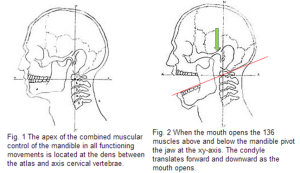
Wow – this is more info than I could process in one sitting! Thank you for so clearly explaining the difference between the jaw joint and others – I’ve forwarded this to all of my colleagues!
Thanks. Dr. Dave Singh and I are developing interdisciplinary protocols for atlas orthogonal specialists and dental specialists.
This is really interesting, You are a very skilled blogger.
I have joined your feed and look forward to seeking more of
your magnificent post. Also, I’ve shared your web site in my social networks!
Could you please give me contacts of dentists and chiropractors who master your techniques in Europe?
I live in Spain.
Following a very negligent dental treatment my head has tilted and I have gone within 24 hours from being an athlete running 10 k every day to havi g a twisted spine, missaligned meck and head, asymmetric posture, tilted pelvis, shoulders at different hights and sore muscles all over. My jaw moved sideways and the midline of incisives is now more than 7 mm apart.
I need help.
My email is info@leonardmazza.com
Thank yoy very mu h in advance.
Hello Professor Mazza:
I certainly empathize with your circumstance. The teeth are the gears of the body, and as such, they have a significant influence over the body’s posture systems. I have heard too many versions of your story. There is a protocol that I have developed that can likely help. I’d be happy to have a consultation with you over the phone, and to facilitate that, please call our office and ask to speak with Joyce. 011-801-655-1801
Best Wishes,
Dr. Chapman